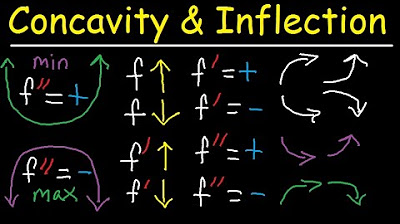Maxima Minima Slope Intuition
TLDRThe video script discusses the fundamental concepts of concavity, maxima, minima, and inflection points in calculus, typically introduced in the first semester. It emphasizes the importance of understanding the underlying intuition rather than just memorizing rules for exams. The speaker explains how the first derivative being zero indicates interesting points on a curve and how the sign of the second derivative relates to the concavity of the function. The goal is to provide a deeper understanding that will be remembered beyond the classroom.
Takeaways
- 📚 The video discusses key concepts in calculus such as concavity, maxima, minima, and inflection points.
- 🧠 The importance of understanding the intuition behind calculus concepts rather than just memorizing rules is emphasized.
- 📈 The video introduces the concept of 'interesting points' on curves where the slope is equal to zero.
- 🔍 The local maximum and minimum points on a curve are identified by the first derivative being zero and the slope changing from negative to positive or vice versa.
- 🔽 At a local minimum point, the graph is concave upward, and the first derivative changes from negative to positive.
- 🔼 At a local maximum point, the graph is concave downward, and the first derivative changes from positive to negative.
- 📊 The second derivative can be thought of as the slope of the first derivative, providing insight into the concavity of the function.
- ✅ A positive second derivative indicates the function is concave upward, while a negative second derivative indicates it is concave downward.
- 🤔 The video encourages viewers to think about the rate of change and how it relates to the slope and concavity, rather than just memorizing patterns.
- 📞 The speaker plans to cover inflection points in a future video and provide examples from calculus textbooks.
- 🎓 The ultimate goal is to provide a solid intuitive understanding of calculus that goes beyond just passing exams.
Q & A
What are the three types of interesting points typically found on the curves in a first semester calculus course?
-The three types of interesting points are maximum points, minimum points, and inflection points.
Why is it important to develop intuition for calculus concepts rather than just memorizing the rules?
-Developing intuition helps in long-term retention and application of the concepts, whereas memorization may lead to forgetting the rules after exams or over time.
How can you identify a local maximum point on a curve?
-A local maximum point can be identified where the slope of the curve is equal to 0, and it is the highest point in its surrounding neighborhood.
What is the significance of the first derivative being zero at interesting points on a curve?
-The first derivative being zero indicates that the slope of the curve at that point is 0, which is a characteristic of maximum, minimum, and inflection points.
What does the concavity of a graph tell us about the second derivative?
-If the second derivative is positive, the graph is concave upwards, and if it is negative, the graph is concave downwards. This provides insight into the shape of the graph and the behavior of the function at extrema points.
How does the slope of a tangent line to a curve change as you move from left to right on a graph that has a minimum point?
-The slope of the tangent line becomes less negative, reaches zero at the minimum point, and then becomes positive as you move further to the right.
What is the relationship between the first and second derivatives at a minimum point?
-At a minimum point, the first derivative is zero, and the second derivative is positive, indicating that the slope of the curve is increasing and the graph is concave upwards.
How does the graph of the second derivative look for a quadratic function like y = ax^2 + b?
-The graph of the second derivative for a quadratic function y = ax^2 + b is a constant line, since the derivative of 2ax is just 2a, which is a constant number.
What happens to the slope of the derivative as you move from left to right on a graph that has a maximum point?
-The slope of the derivative decreases from a high value, becomes 0 at the maximum point, and then continues to decrease, becoming more negative as you move further to the right.
How can you tell if a point on a curve is an inflection point?
-A point on a curve is an inflection point if the graph changes concavity at that point, but it is not a maximum or minimum point.
What will be covered in the next video after the one described in the transcript?
-The next video will provide intuition on inflection points and then proceed with examples from a calculus textbook.
Outlines
📚 Introduction to Calculus Concepts
The speaker begins by expressing their intention to create a series of videos covering fundamental calculus topics such as concavity, maxima, minima, and inflection points. They aim to provide a deeper understanding beyond just memorizing rules for exams. The speaker introduces the concept of three types of interesting points on curves typically encountered in first-semester calculus: points where the slope is zero, which correspond to local and global maxima and minima, as well as inflection points where the graph changes direction. They illustrate these points with a手绘 curve and explain that the slope of the tangent line at these points is what makes them significant in calculus. The speaker emphasizes the importance of understanding the behavior of the first and second derivatives at these points of interest.
📈 Analysis of Minimum and Maximum Points
In this section, the speaker delves deeper into the characteristics of minimum and maximum points on a curve, using the analogy of a parabola to explain these concepts. They discuss the behavior of the first derivative as it transitions from negative to positive, indicating a minimum point where the slope increases from negative to zero and then becomes positive. The speaker then introduces the concept of the second derivative, describing it as the 'slope of the slope' and explaining its role in determining whether a point is a minimum (concave up) or a maximum (concave down). They illustrate this with a hypothetical second-degree polynomial and describe how the second derivative would appear as a constant positive value in the case of a minimum. The speaker also touches on the behavior of the derivatives in the case of a maximum point, where the first derivative decreases from positive to zero and then becomes negative, and the second derivative is a constant negative value, indicating concavity downwards.
Mindmap
Keywords
💡Calculus
💡Concavity
💡Maxima and Minimum Points
💡Inflection Points
💡Derivatives
💡Second Derivatives
💡Slope
💡Tangent Lines
💡Graphing
💡Extrema
Highlights
The speaker discusses the concept of concavity, maxima, minima, and inflection points in calculus.
The importance of understanding the intuition behind calculus concepts rather than just memorizing rules is emphasized.
The speaker introduces the idea that the interesting points on a curve often occur where the slope is equal to zero.
A local maximum and global maximum are differentiated, with the local maximum being a high point on a segment of the curve.
A local minimum and global minimum are explained, with the global minimum being the lowest point on the entire graph.
An inflection point is defined as a point on the curve where the graph changes direction but is neither a maximum nor a minimum.
The speaker provides a visual representation of a curve with maximum, minimum, and inflection points.
The relationship between the first derivative being zero and the slope of the curve is explored.
The concept of concavity and how it relates to the second derivative being positive or negative is discussed.
The speaker explains how the slope changes around a minimum point and how it indicates concavity.
The transition from a minimum to a maximum point is described, with the opposite behavior of the slope and concavity.
The speaker plans to cover inflection points in more detail in a future video.
The video aims to provide a deeper understanding of calculus concepts beyond just passing exams.
The speaker uses the example of y = ax^2 + b to illustrate the concepts of derivatives and concavity.
The video concludes with a promise to cover more examples and problems in future content.
Transcripts
Browse More Related Video

Concavity, Inflection Points, Increasing Decreasing, First & Second Derivative - Calculus

Using the Second Derivative (1 of 5: Finding the Point of Inflexion)

Learn how to determine concavity and point of inflection AP style

MATH1325 Lecture 10 2 - Concavity & Points of Inflection

Business Calculus - Math 1329 - Section 3.2 - Concavity and Points of Inflection

Concavity introduction | Using derivatives to analyze functions | AP Calculus AB | Khan Academy
5.0 / 5 (0 votes)
Thanks for rating: